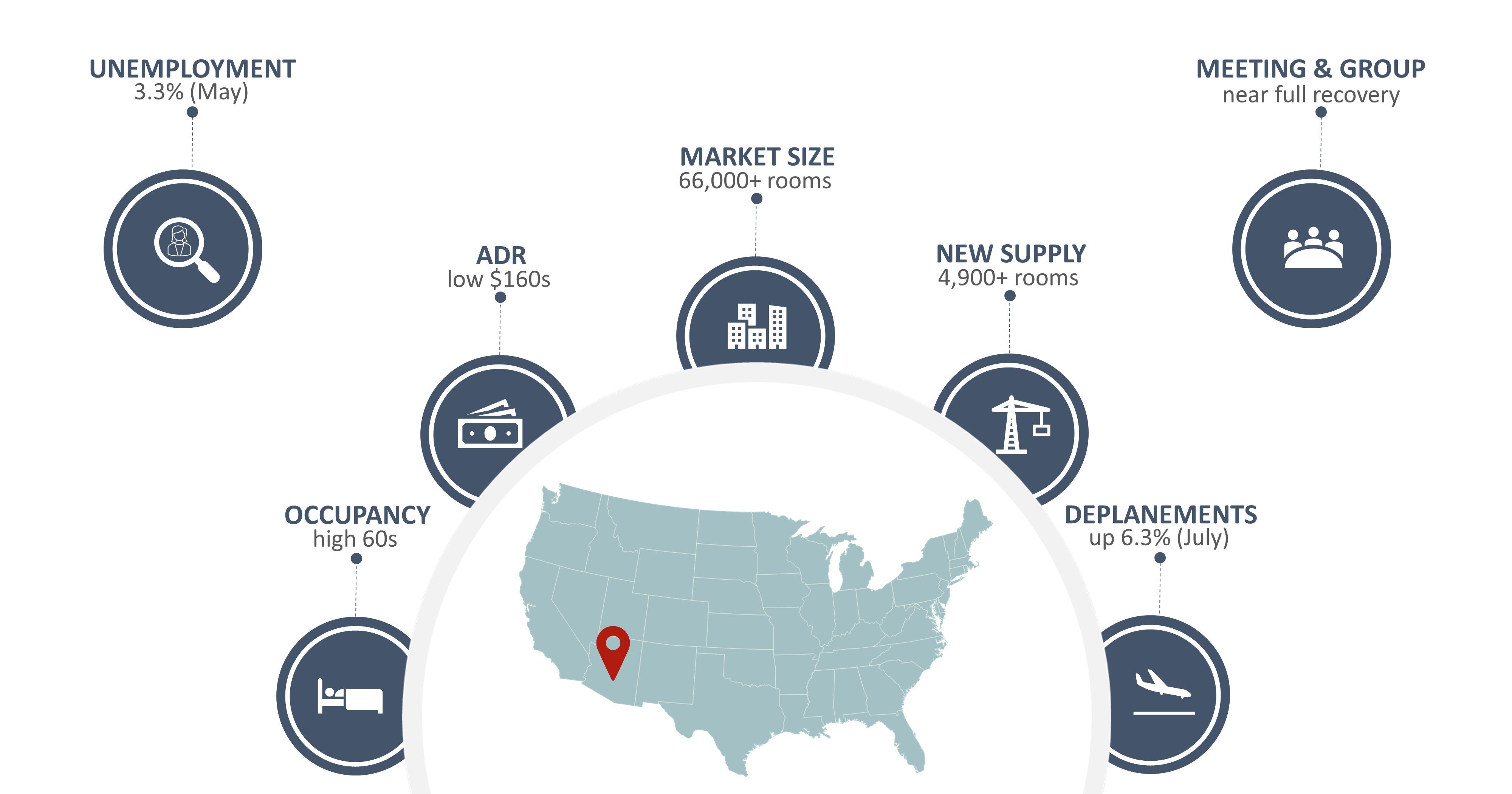By Zabada N. Abouelhana, McKenna Luke, Aleisha Smith
Phoenix has come a long way in the last decade, developing a diverse and welcoming economy that has allowed the city and surrounding communities to outperform other top-25 markets. Area officials and industry partners have made a concerted effort to grow the metro in a meaningful and multi-faceted way beyond the somewhat stable demand drivers of the former decades that slowed the recovery from the Great Recession. Furthermore, operators and officials were able to capitalize on the Super Bowl held in 2015 to grow overall RevPAR to a pre-pandemic high in 2019. Demand during that period was boosted by increases in commercial activity throughout Phoenix, including the resurgence of Downtown Phoenix and the expansion of Class-A office development in the outlying submarkets of Tempe, Mesa, Gilbert, Chandler, and North Scottsdale. While the state government, Arizona State University, and the construction industry have long been economic stalwarts in Phoenix, diversification efforts have successfully attracted major employers in the medical research, technology, financial services, and insurance industries over the past decade.
Latest Phoenix Market Data
The strength of the pre-pandemic first quarter of 2020 in Phoenix resulted in the lowest RevPAR decline among the top 25 markets for the year. Transient demand from areas with stricter COVID-19 restrictions bolstered occupancy, and the Phoenix Convention Center (PCC) and area resorts experienced demand growth in the second half of the year. By 2022, occupancy had rebounded to 97% of the 2019 level, while ADR and RevPAR well surpassed pre-pandemic levels, driven by the improvement in pricing power, shift in segmentation, and continued evolution of the destination. This positive trend continued in 2023 due to the full-capacity return of MLB Spring Training and the presence of the Super Bowl in February 2023. ADR and RevPAR increases began to soften in the second quarter of the year, while some demand softening or contraction has been noted given alternative destinations and the return of more typical seasonality. However, the long-term outlook remains optimistic given the continued strengthening of international tourism, commercial demand, and meeting/group events.
HVS has forecast occupancy for this market to end at a similar level to 2022, in the upper 60s, and then rebound to 2018/19 levels, at roughly 70%, in 2024. After notable gains in both occupancy and ADR during the first quarter of 2023, a return to more typical seasonality trends and record summer temperatures resulted in a relatively stable occupancy from April through August. The last quarter of 2023 is expected to undergo a modest correction to more typical occupancy levels, without the pent-up demand recorded in 2022. Rate growth has been forecast at 7% in 2023, notably above the national forecast, due to the strong ADR from hosting the Super Bowl. However, ADR has increased notably in recent years, surpassing 2019 levels by 30%. This is due in part to rate gains during the peak season and special events, as well as the elevation of the destination. ADR is expected to remain stable in 2024 despite the lack of the Super Bowl, which will be somewhat offset by Final Four.
Major factors that contribute to our forecast and investors’ outlook of the market are outlined as follows:
- Phoenix remains a major domestic and international tourism destination.
- Phoenix Sky Harbor International and Phoenix-Mesa Gateway airports have both exceeded the pre-pandemic passenger peaks, driven by the addition of flights and growth of the metro area.
- Special events throughout the peak season, professional sports teams, youth sports activities, and the growing number of leisure attractions support the desirability of the destination.
- Economic investment continues despite rising construction costs and interest rates, as well as the current lending market. Phoenix has become the “semiconductor desert” of the world.
- Taiwan Semiconductor Manufacturing Company (TSMC) is constructing two semiconductor plants, for a total investment of $40 billion, which will together create over 10,000 full-time jobs by completion in 2024 and 2026.
- A $20-billion expansion, including two new semiconductor facilities, is underway at the Intel campus in Chandler; Intel plans to add approximately 3,000 to its existing workforce of over 11,000.
- LG Energy plans to invest $5.5 billion into a new battery-manufacturing plant in Queen Creek, which is expected to be operational by 2025.
- In April 2022, the Mayo Clinic broke ground on a $135-million research building on its North Phoenix campus. This project is part of a $748-million expansion that will double the size of the campus and add 2,000 high-wage jobs by 2024.
- The meeting and group segment has historically accounted for 20% of total demand in the Phoenix metro area. Scottsdale is the leader for this segment given the plethora of resort-style, group-oriented resorts in this submarket.
- During the height of the pandemic, the group segment accounted for a much lower share of demand, especially given the record transient ADRs achieved within the Phoenix market. As leisure demand softened, the market rapidly regained meeting and group demand, reaching 2019 levels in 2022.
- Citywide and convention demand rapidly rebounded and continues to grow. The number of delegates attending events at the PCC reached pre-pandemic levels in 2022, and a very strong contribution/booking pace in 2023 bodes well. The city’s focus has been on increasing demand in the summer months and creating a less seasonal market, which was reportedly successful in 2023, when the Downtown submarket experienced a strong July due to meeting and group demand.
- In the summer of 2023, long-term plans for a convention center expansion were announced based on a recent study. The plans include a new 150,000-square-foot exhibit hall, a convention center hotel, and an entertainment district. This development would help to further boost the profile of the Phoenix market.
However, new supply, construction/renovation costs, and the cost of capital remain concerns in the market. All eyes are set on Phoenix given its expected supply increase of nearly 20% with more than 120 projects over the next five to seven years. The market is trending behind only Nashville, Tennessee, in terms of hotels in the planning, final planning, and construction phases of development as a percentage of existing supply. In recent years, strong growth in supply has occurred in both the East and West Valleys of Phoenix. Some recent hotel openings include the 237-room Hilton North Scottsdale at Cavasson, which opened at the start of this year, and the 300-room Omni Tempe Hotel at ASU, which opened in April 2023 and features over 35,000 square feet of meeting space.
Several high-end resorts and hotels are currently under construction, including the largest resort in Arizona: the 1,100-room VAI Resort in Glendale. The VAI is on track to open in 2024 and will feature a multi-level concert venue, a two-story nightclub, a swimming oasis and lagoon bar, and over ten restaurants.
Other major hotel developments in the greater area include the 141-room Global Ambassador (Sam Fox’s hotel) in Phoenix, which is expected to open in mid-November 2023 and feature the largest rooftop in the state, five specialty restaurants, and an exclusive members-only wellness club; the 265-room Caesars Republic (the company’s first non-gaming hotel) in Scottsdale, opening in February 2024; and the 215-room Ritz-Carlton Hotel and Residences in Paradise Valley, which has been delayed for years but recently received financing to complete construction by mid-year 2024. With the influx of these leisure-oriented properties in Scottsdale, we expect the leisure contribution to grow more quickly than the group segment in this submarket.
Supply growth is expected to wane somewhat given construction costs, competition for construction laborers in the market, water-resource concerns, and the high-interest-rate environment; however, the fundamentals of many Phoenix submarkets remain strong, and pockets of hotel demand are still underserved.
Investors remain bullish on the Phoenix market despite high debt and construction costs that have slowed development of some projects throughout Phoenix and the nation. Nevertheless, there continues to be a strong appetite for high-quality deals, and hotels remain a popular investment asset class in the prevailing inflationary environment.
The market has long been popular with REITs and equity funds, as well as institutional and cross-border investments at the upscale and luxury levels. In 2019, approximately 80% of the hotel transaction volume in the Phoenix market was initiated by REITs, equity funds, and investment managers, indicating a strong interest by institutional investors in the Arizona market. Upscale transactions, particularly of select-service and extended-stay properties, have historically comprised the greatest share of transactions. If the luxury transactions (one per year) were excluded from the total transaction volume, the upscale segment equaled between 62% of the volume in 2019 and 43% in 2022, with a general downward trend driven by midscale gains. Furthermore, the transaction volume has historically been influenced by large assets, such as the JW Marriott Phoenix Desert Ridge Resort & Spa. This property made up 55% of the transaction volume in 2019, selling for $602 million ($633,684 per key).
The Greater Phoenix area has grown from an investor standpoint, and three record sales have occurred within the last twelve months: The Camby Hotel ($110,000,000, or $397,112 per key), AC Hotel Phoenix Biltmore ($67,800,000, or $423,750 per key, at a roughly 7.0% cap rate), and Four Seasons at Troon North ($267,800,000, or $1,275,238 per key, at a cap rate of 5.3%). Prior to these transactions, the Sanctuary on Camelback sold for $133,000,000 or $1,198,198 per key; however, this resort transaction included the potential for expansion, a residential component, and a rental management program (5.6% cap). A number of other key transactions have occurred in the past several years, but since the pandemic, the market’s resilience, ADR potential, growing population, and strong commercial demand base have driven increased investment demand, with notable capital being extended. Several redevelopment projects included a substantial initial investment, followed by another large capital infusion to transform the asset.
Overall, investor interest in the greater Phoenix market has continued to grow, with the price per key across all segments reaching 132% to 200% of the 2019 price per key. In addition to the price per key rising notably, the number of transactions has increased more than 150%, from 35 in 2019 to 51 in 2022; however, this increase was driven by roughly half of the transactions occurring as part of portfolio sales. Year-to-date 2023 transactions and total volume are notably below those in the first half of 2022 given the cost of capital pressures, even when the portfolio transactions are removed; however, the total transaction volume year-to-date has exceeded that of the same period in 2019 given pricing gains and higher-caliber assets trading. Finally, the total investment on a per-key basis for year-to-date 2023 is higher than that of 2019 and 2022 combined as investors continue to capitalize on the increased RevPAR and EBITDA achieved over the last several years, which are elevating the Phoenix market.
The Greater Phoenix economy continues to grow, with the desirability of the region from live, work, and play perspectives driving population and economic expansions. Furthermore, the business-friendly atmosphere, ability to drive higher ADR during the peak season, and high desirability as a leisure and meeting and group destination continue to bolster investor expectations of the market. Although the period of double-digit revenue growth for the Greater Phoenix market may have ended, investor interest is not expected to cool.
Thanks to the HVS Brokerage & Advisory team for their always-valuable insights. For more information on the Phoenix lodging market, please contact Zabada Abouelhana with the HVS Phoenix office.







